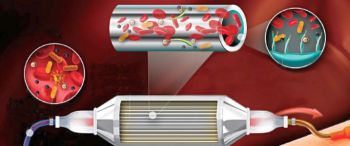
Publisher:
Bonnie King
CONTACT:
Newsroom@Salem-news.com
Advertising:
Adsales@Salem-news.com

~Truth~
~Justice~
~Peace~
TJP
Jun-26-2014 05:45

 TweetFollow @OregonNews
TweetFollow @OregonNews
Engineers at Oregon State Develop New Technology to Treat and Prevent Sepsis
Salem-News.com StaffWith early treatment, sepsis can sometimes be successfully treated with antibiotics.
 Engineers at Oregon State University have developed a new technology that they believe could revolutionize the treatment and prevention of sepsis. Photo Courtesy: Oregon State University |
(CORVALLIS, Ore. ) - The National Science Foundation has just awarded $200,000 to engineers at Oregon State University who have developed a new technology that they believe could revolutionize the treatment and prevention of sepsis.
Sepsis is a “hidden killer” that in the United States actually kills more people every year than AIDS, prostate cancer and breast cancer combined.
More commonly called “blood poisoning,” sepsis can quickly turn a modest infection into a whole-body inflammation, based on a dysfunctional immune response to endotoxins that are released from the cell walls of bacteria. When severe, this can lead to multiple organ failure and death.
When treatment is begun early enough, sepsis can sometimes be successfully treated with antibiotics. But they are not always effective and the mortality rate for the condition is still 28-50 percent. About one in every four people in a hospital emergency room is there because of sepsis, and millions of people die from it around the world every year, according to reports in the New England Journal of Medicine and other studies.
In pioneering research, OSU experts have used microchannel technology and special coatings to create a small device through which blood could be processed, removing the problematic endotoxins and preventing sepsis. Several recent professional publications have reported on their progress.
“More work remains to be done, and the support from the National Science Foundation will be instrumental in that,” said Adam Higgins, principal investigator on the grant and an assistant professor in the OSU School of Chemical, Biological and Environmental Engineering. “When complete, we believe this technology will treat sepsis effectively at low cost, or even prevent it when used as a prophylactic treatment.”
This technology may finally offer a way to tackle sepsis other than antibiotics, the researchers said.
“This doesn’t just kill bacteria and leave floating fragments behind, it sticks to and removes the circulating bacteria and endotoxin particles that might help trigger a sepsis reaction,” said Karl Schilke, the OSU Callahan Faculty Scholar in Chemical Engineering.
“We hope to emboss the device out of low-cost polymers, so it should be inexpensive enough that it can be used once and then discarded,” Schilke said. “The low cost would also allow treatment even before sepsis is apparent. Anytime there’s a concern about sepsis developing – due to an injury, a wound, an operation, or an infection – you could get ahead of the problem.”
“A big part of the problem with sepsis is that it moves so rapidly,” said Joe McGuire, professor and head of the OSU Department of Chemical, Biological and Environmental Engineering. “By the time it’s apparent what the problem is, it’s often too late to treat it.
“If given early enough, antibiotics and other treatments can sometimes, but not always, stop this process,” McGuire said. “Once these bacterial fragments are in the blood stream the antibiotics won’t always work. You can have successfully eradicated the living bacteria even as you’re dying.”
The approach being developed at the OSU College of Engineering is to move blood through a very small processor, about the size of a coffee mug, and literally grab the endotoxins and remove them.
Microchannels make this possible. They can provide accelerated heat and mass transfer as fluids move through tiny tubes the width of a human hair. Applications are already being studied in everything from heat exchangers to solar energy. They can be produced in mass quantity at low cost, stamped onto a range of metals or plastics, and used to process a large volume of liquid in a comparatively short time.
In the system developed at Oregon State, blood can be pumped through thousands of microchannels that are coated with what researchers call “pendant polymer brushes,” with repeating chains of carbon and oxygen atoms anchored on the surface. This helps prevent blood proteins and cells from sticking or coagulating. On the end of each pendant chain is a peptide – or bioactive agent – that binds tightly to the endotoxin and removes it from the blood, which then goes directly back to the patient.
Sepsis is fairly common. It can develop after an injury from an automobile accident, a dirty wound, an extended operation in a hospital that carries a risk of infection, or infectious illnesses in people with weak or compromised immune systems.
In the U.S., more than $20 billion was spent on this problem in 2011. It’s the single most expensive cause of health problems that require hospitalization.
Source: Oregon State University
Articles for June 25, 2014 | Articles for June 26, 2014 | Articles for June 27, 2014
Quick Links
DINING
Willamette UniversityGoudy Commons Cafe
Dine on the Queen
Willamette Queen Sternwheeler
MUST SEE SALEM
Oregon Capitol ToursCapitol History Gateway
Willamette River Ride
Willamette Queen Sternwheeler
Historic Home Tours:
Deepwood Museum
The Bush House
Gaiety Hollow Garden
AUCTIONS - APPRAISALS
Auction Masters & AppraisalsCONSTRUCTION SERVICES
Roofing and ContractingSheridan, Ore.
ONLINE SHOPPING
Special Occasion DressesAdvertise with Salem-News
Contact:AdSales@Salem-News.com

googlec507860f6901db00.html



Terms of Service | Privacy Policy
All comments and messages are approved by people and self promotional links or unacceptable comments are denied.
[Return to Top]
©2025 Salem-News.com. All opinions expressed in this article are those of the author and do not necessarily reflect those of Salem-News.com.